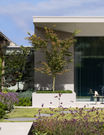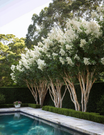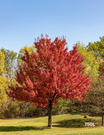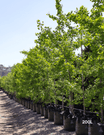Many homeowners aspire to create an outdoor space that is functional and visually stunning. Trees play a pivotal role in this endeavor, particularly when it comes to framing and highlighting sculptures, fountains, and other garden art. This article will explore how strategically placed trees can enhance outdoor features, improve air quality, and offer valuable planting tips.
Eucalyptus mannifera (Brittle Gum)
The Eucalyptus mannifera, commonly known as the Brittle Gum, is a striking tree characterized by its smooth, mottled bark and elegant foliage. With its tall stature and unique form, this tree serves as a dramatic backdrop for outdoor sculptures or a standalone feature that commands attention.
Key Facts
- Mature Height: 15–25 meters
- Mature Width: 8–12 meters
- Best Uses: Feature tree, shade provider
- Leaf Appearance: Glossy, lance-shaped leaves that are aromatic when crushed
- Rate of Growth: Moderate to fast
- Tolerates: Drought, poor soil conditions

Why It's Perfect to Add to Your Garden
Eucalyptus mannifera is not just a beautiful addition to any high-end garden; it also filters air pollutants and improves local air quality, making your outdoor space healthier. Its striking appearance can effectively frame sculptures, drawing the eye and enhancing the overall aesthetic of your garden. Planted thoughtfully, it can provide a canopy of shade for seating areas or artistic features, creating a serene atmosphere that encourages relaxation.
The tree's bark sheds naturally, adding a layer of visual interest and allowing for easy maintenance without extensive pruning. Its resilience to various environmental conditions makes it an ideal choice for urban and rural gardens.
Lagerstroemia indica (Crape Myrtle)
Lagerstroemia indica, or Crape Myrtle, is celebrated for its vibrant blooms and stunning bark. In summer, this tree's colorful flowers can brighten any garden, making it an excellent choice for enhancing outdoor art installations or fountains.
Key Facts
- Mature Height: 3–8 meters
- Mature Width: 3–6 meters
- Best Uses: Feature tree, informal hedge
- Leaf Appearance: Glossy green leaves that turn brilliant colors in autumn
- Rate of Growth: Fast
- Tolerates Heat, drought, and urban pollution

Why It's Perfect to Add to Your Garden
The Crape Myrtle’s seasonal blooms add a splash of color and vibrate your outdoor art. Its adaptability to various soil types and conditions makes it an excellent choice for diverse gardens. Additionally, as it matures, its smooth, peeling bark provides winter interest, allowing your garden to maintain its appeal even in colder months.
Not only does the Crape Myrtle enhance the visual impact of your garden, but it also serves as an excellent privacy screen when planted in clusters. The filtering effect of its foliage contributes to a cleaner environment, enhancing the air quality around your outdoor space.
Quercus suber (Cork Oak)
Quercus suber, commonly known as the Cork Oak, is a remarkable evergreen tree prized for its unique bark and various uses. Indigenous to the western Mediterranean region, this oak species boasts a stunning appearance and commercial value, making it a distinctive addition to gardens, landscapes, and even the world of industry.
Key Facts
- Mature Height: 15–25 meters
- Mature Width: 10–15 meters
- Best Uses: Feature tree, shade tree
- Leaf Appearance: Dark green, leathery leaves that provide a dense canopy
- Rate of Growth: Slow to moderate
- Tolerates: Drought, poor soil

Why It's Perfect to Add to Your Garden
The Quercus suber’s unique bark can beautifully frame outdoor art, creating a distinctive backdrop for sculptures or fountains. Its expansive canopy offers cooling shade, making it perfect for enhancing leisure areas. Moreover, this tree significantly improves local air quality by filtering pollutants, ensuring your garden is visually appealing and environmentally friendly.
Cork bark can be harvested sustainably, adding an element of utility to its aesthetic appeal. Its slow growth rate means it will develop into a stable, enduring feature that adds character to your landscape over time, making it a wise investment for any discerning homeowner.
Additional Benefits of Using Trees in Your Garden
- Enhanced Privacy: Strategically placed trees can create natural barriers, offering seclusion from neighbors while framing your outdoor art.
- Improved Wildlife Habitat: Trees attract birds and beneficial insects, adding life and movement to your garden.
- Increased Property Value: Mature trees contribute significantly to property value, making your investment in quality landscaping worthwhile.
- Seasonal Interest: With varied foliage and seasonal blooms, these trees ensure your garden remains visually engaging throughout the year.
Conclusion
Incorporating trees like Eucalyptus mannifera, Lagerstroemia indica, and Quercus suber into your outdoor space can dramatically enhance your garden's aesthetics while providing practical benefits such as air purification and shade. Thoughtful placement of these trees will frame and highlight your outdoor art and features, creating a luxurious and inviting atmosphere. By selecting the right trees and understanding their unique qualities, you can create a thriving garden that reflects your taste and values.
FAQs
Q: How do trees improve air quality?
A: Trees filter air pollutants by absorbing carbon dioxide and releasing oxygen, improving local air quality and creating a healthier environment.
Q: What is the best time to plant these trees?
A: The best time to plant is during the cooler months of spring or autumn when the soil is moist and temperatures are moderate.
Q: How much maintenance do these trees require?
A: All three trees mentioned are relatively low maintenance once established, requiring occasional watering and pruning to maintain shape and health.
Q: Can these trees thrive in poor soil?
A: Both Eucalyptus mannifera and Quercus suber can tolerate poor soil conditions, making them versatile choices for various garden settings.
































Leave a comment
This site is protected by hCaptcha and the hCaptcha Privacy Policy and Terms of Service apply.